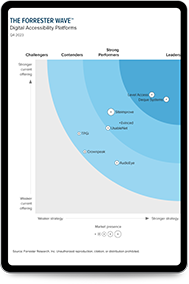WCAG for Mobile Apps
Mar 7, 2022
Mobile apps continue to proliferate, adding convenience to our lives—but that doesn’t always translate to a better experience for everyone. Many apps are not created with all users in mind, which can make them frustrating, difficult, or even impossible for people with disabilities to use. Fortunately, there is a roadmap for making mobile apps and mobile versions of websites accessible.
The Web Content Accessibility Guidelines (WCAG) provide a comprehensive set of criteria for accessible digital content. Originally created for websites, WCAG is also the best-practice standard for all types of digital experiences, including mobile apps. While WCAG itself is not a piece of legislation, it has been accepted as the global standard for web accessibility. In fact, legal compliance with many international regulations—including Section 508 of the Rehabilitation Act in the U.S.—requires WCAG conformance. So, how does WCAG apply to mobile accessibility? In this post, we discuss WCAG for mobile apps and making web content accessible via devices like phones and tablets.
Are mobile apps required to be accessible?
Is mobile accessibility a requirement? As a practical matter, yes. The Americans with Disabilities Act (ADA) is consistently being interpreted to include websites and web content, leading to a growing list of lawsuits citing inaccessible content. Mobile apps and mobile versions of websites are included in such lawsuits, many of which have centered on mobile accessibility issues such as incompatibility with Apple’s VoiceOver screen reader. In fact, the famous Domino’s Pizza accessibility lawsuit included complaints about the company’s mobile app. In addition, laws like Section 508 of the U.S. Rehabilitation Act, which applies to agencies and vendors of the federal government, require the accessibility of any owned information and communications technology (ICT). So whether a private business or public agency, it’s best practice for most organizations, morally and legally, to ensure accessibility of their apps.WCAG does not include separate guidelines for making mobile apps and mobile versions of websites accessible. However, app developers should look to WCAG as the gold standard for mobile app accessibility. In addition, the organization that publishes WCAG, the World Wide Web Consortium (W3C), has created a Mobile Accessibility Task Force to clarify and expand the WCAG criteria for mobile content and apps. The task force has published a guide describing how WCAG applies to mobile web content, mobile web apps, native apps, and hybrid apps using web components inside native apps. While the guide focuses on WCAG 2.0, we recommend that organizations follow the criteria outlined in the newer versions of WCAG, since the U.S. Department of Justice has begun to point to at least WCAG 2.1 as the desired standard in its private enforcement actions. What’s more, an even newer version of WCAG, WCAG 2.2, has now been published, making the older 2.0 version less likely to hold weight.Learn more about the different versions and conformance levels of WCAG.
What creators should know about WCAG for mobile apps
The WCAG accessibility criteria are based on four principles: perceivable, operable, understandable, and robust (often referred to as POUR). In its guide on WCAG for mobile, the W3C Mobile Accessibility Task Force relates these principles to mobile web content and mobile apps, and describes common accessibility issues, or considerations, that fall under each principle. By following these principles, developers can create apps and mobile versions of web content that can be perceived, easily operated, and clearly understood by all people, including those who use assistive technology, have visual impairments, or require alternative manipulation gestures on mobile interfaces.
- Principle 1 — Perceivable: This category is all about how the app is presented for users, including how smaller screen size affects what is observable on a page, the placement and color contrast of buttons and hyperlinks, and anything else users need to be able to perceive in order to use the app. Accessibility issues in this category include screen size, zoom/magnification capabilities, and ensuring sufficient contrast.
- Principle 2 — Operable: Mobile accessibility issues in this category include enabling keyboard control for touchscreen devices, optimizing touch target size and spacing and button placement, and providing instructions (e.g., tooltips, tutorials, etc.) for alternative touchscreen gestures and device manipulation gestures for people who need them. To align with this principle, developers should make sure that the ways people interact with the app or mobile site—such as touching buttons, scrolling, etc.—are free from barriers.
- Principle 3 — Understandable: Essentially, this category is all about making sure that all users can clearly understand how to use the app or mobile site and how to customize their settings if necessary. Mobile accessibility issues in this category include the ability to change screen orientation, ensuring consistent layout, positioning important page elements before the scroll, grouping operable elements that perform the same action, providing clear indication that elements are actionable, and providing instructions for custom touchscreen and device manipulation gestures.
- Principle 4 — Robust: This category is concerned with how well the app or mobile site’s interface is supported across devices and operating systems. Mobile accessibility issues in this category include setting the virtual keyboard to the type of data entry required, providing easy methods for data entry, and supporting the characteristic properties of the platform, for example, the device and operating system. Differences among devices and operating systems may affect the availability of certain accessibility functions such as adjusting font size or wrapping text that has been enlarged.
When put into practice, these principles allow developers to provide the flexibility necessary for their apps and mobile sites to adapt to users’ needs rather than the other way around.Much of this flexibility comes down to decisions made by developers early in the design process. For example, one developer recommends leaving the landscape mode enabled when developing apps and mobile versions of sites, which removes barriers for people who use a larger text size, whose devices are locked into position (e.g., on a wheelchair mount), and more.
Accessibility starts with design
WCAG—specifically WCAG version 2.1 AA and beyond—enables organizations to improve their existing web content and mobile apps in order to comply with legal requirements and make their products accessible to all. But as the saying goes, an ounce of prevention is worth a pound of cure; app and web content developers can save themselves time and trouble by implementing WCAG for mobile apps from the beginning of the design process. Check out our tips for developing accessible mobile apps.Whether you’re designing a new app or need help ensuring your existing app or mobile-friendly website is accessible, eSSENTIAL Accessibility is your all-in-one solution to digital accessibility. We have the experience to advise developers and designers alike, equip you with an accessibility roadmap that optimizes your existing workflows, and help you reach your goals with advanced technology, expert advice, and ongoing training and support. Learn more about our platform today.
Subscribe for updates

